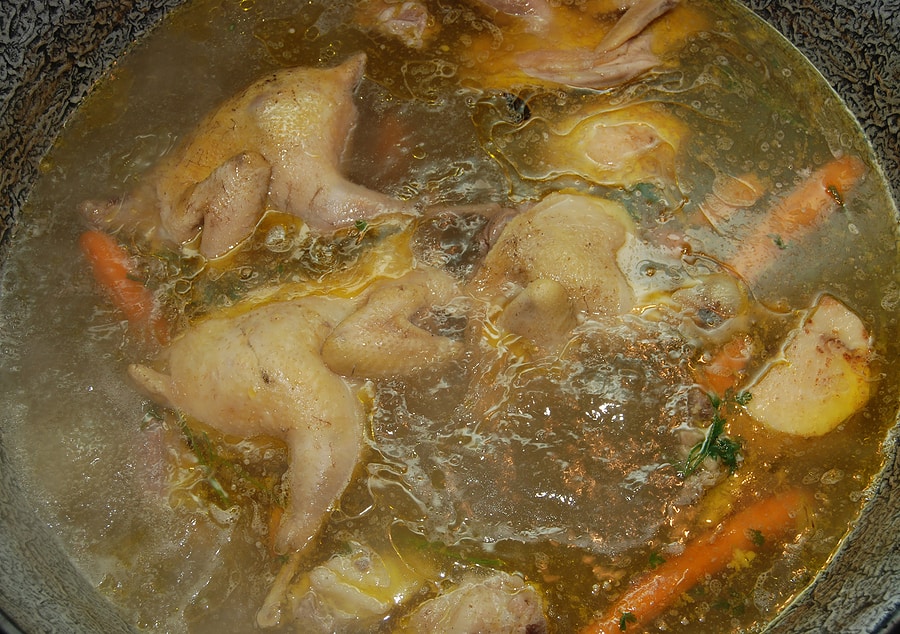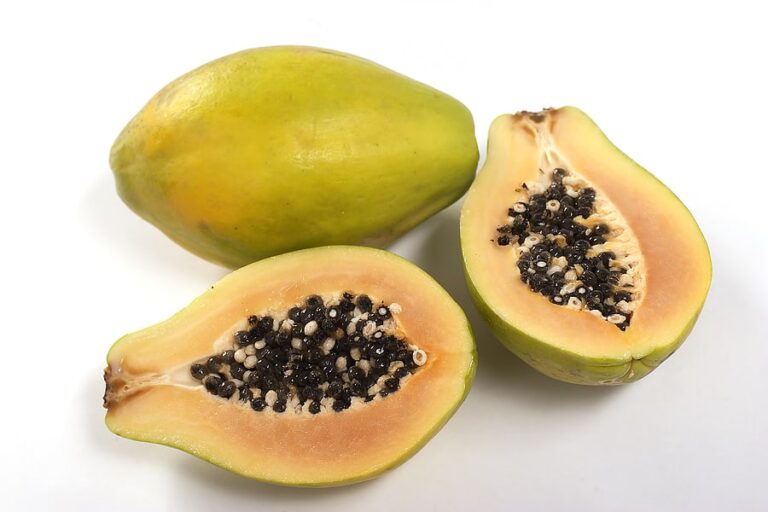How to Make Chicken Stock With No Recipe

I make many flavorful soups year-round using vegetables from my kitchen garden. Chicken stock and vegetable stock are the base for many of these. Here’s how I make chicken stock:
Chicken stock is a basic preparation used to make many soups and sauces. Chicken stock draws its flavor from the bones and meat of a chicken and also often combines the flavor of aromatic vegetables (onions, carrots, celery), herbs, and sometimes wine.
Chicken stock is made starting with cold water and a whole chicken or chicken parts. The flavor of the chicken is drawn from the meat and bones as the water is heated to a boil and intensified–then the mixture is reduced to a simmer and cooked on for 1 to 5 hours.
Slow cooking the bones draws gelatin from the bone and connective tissue which gives chicken stock its silky texture and body. Slow cooking the meat gives chicken stock its flavor. Dark meat sautéed or roasted before cooking will deepen the flavor and make it richer. Adding more water to a stock will make it lighter and more delicate.
To achieve the flavor you desire, taste your stock as it cooks. That way you can judge for yourself when you have gotten exactly the flavor you want.
Making Chicken Stock Without a Recipe:
A mature stewing hen will be much more flavorful than a younger fryer. You can make chicken stock cooking the chicken whole, but for the truly flavorful chicken stock (and to make stock more quickly), use cut up chicken parts such as legs and wings. As well, the chicken carcass or parts of the carcass—necks, backs, scraps, wing tips, and giblets (excluding the liver) are commonly used to make chicken stock.
Preparation: Wash the raw meat, bones, and skin in cold water to remove any surface flavor and blood. If you are using just bones, soak the bones in cold water to remove blood. Cut the meat into thin pieces and crack or cut the bones to increase water penetration during cooking and extract the gelatin and flavor. (Crack and split bones with a poultry shear or cleaver; a knife can nick or slip on the slick surface of bones.)
For the richest flavor, brown the bones and carcass in a skillet on the stove or in the oven at 450°F for 15 to 20 minutes before cooking on in the stock pot. Be sure to drain off all fat after browning and if you brown the meat and bones in the stock pot deglaze (rinse the pot with water) before moving on. If you want a neutral white stock, blanch the raw meat and bones before preparing the stock instead of browning it in advance; blanching means to heat in cold water to a boil then pour off the water.
Ratio: Use between 4 and 8 cups of water for every 2 pounds of chicken meat and bones. The more water the weaker or more delicate the flavor.
Step One: Heat a teaspoon or two of vegetable oil, safflower oil, or mild olive oil over a medium heat and sweat or sauté one medium yellow onion thin sliced until just soft and slightly colored, about 5 to 10 minutes. Set the onions aside.
Step Two: If you have not already browned the chicken, add another tablespoon or two of oil to the stockpot (or kettle or other large pot–with a heavy bottom for even cooking) and heat over medium heat. Sauté the chicken parts until browned, about 4 to 5 minutes. Bones and meat cut into 2 inch pieces will cook thoroughly and quickly. For longer cooking, use a whole hen. (Remember, for a clear stock, you will want to blanch the chicken rather than brown it–as noted above under Preparation.)
Step Three: Add enough cold water to cover the chicken by about 3 inches and bring to a boil–then reduce the heat to a simmer (tiny bubbles gently breaking the surface) and stir. Bubbling will cloud the liquid with tiny droplets of protein and fat; skim off this foam of impurities as it collects on the surface. The objective of skimming is to give the stock as clear appearance as you can.
When you begin simmering the chicken, also add the sautéed onions as well as other aromatic vegetables and herbs for flavor. Aromatic vegetables are root vegetables (carrots, parsnips, turnips) and celery; these are best added coarsely and evenly chopped for even cooking. Aromatic vegetables add sweet sugars and aroma to a stock, but are not required.
Herbs added to stock can include bay leaves (1 large crumbled), parsley stems (3 to 6 sprigs), black peppercorns (about 6 to 8), and thyme (4 sprigs fresh thyme or ½ to 1 teaspoon dried). You may go light on herbs if the dish that calls for stock has its own seasoning requirements. Salt is not added to stock itself but to the soup or sauce that calls for it.
Adjust for flavor the vegetables and herbs you add to stock; as a guide, for each quart of water add one medium onion, one large carrot, and two medium ribs of celery.
To make a lighter more delicate stock, use half the amount of chicken and the same amount of vegetables and water.
Simmer the liquid, chicken, vegetables, and seasoning 1, 2, 3, 4, or 5 hours partially covered–tasting for flavor will determine how long you simmer the liquid. Quick cooking note: Chicken parts cut into 2 inch pieces that have been browned in advance with onions sautéed in advance can add flavor to stock in as short as 20 minutes; larger pieces or a whole hen will require 2 to 5 hours.
Simmer until the meat falls from the bone. Adjust the cooking time to the meat. Meat and bones from older chickens require longer cooking to release their gelatin. Make sure that as you simmer, the solids–meat, bones, and vegetables–are just covered with liquid. Skim the foam occasionally during cooking.
When the flavor is right, stop cooking. For a slow cooking whole hen, you will not need 5 hours or more to prepare stock.
Step Four: Strain the contents of your stock pot through a very fine sieve or a colander lined with several thicknesses of dampened cheesecloth. If you don’t have a sieve or colander, you can ladle the liquid from the pot. Reserve the liquid–your flavorful stock, and discard the chicken meat, bones, and vegetables.
Step Five: If you are not using the stock immediately, allow it to cool to lukewarm room temperature then refrigerate it covered until the liquid fat rises to the surface and solidifies, in 4 to 8 hours. You can defat chilled stock by scraping the congealed fat from the surface. If you plan to use the stock right away, let it cool for a short time then spoon off the fat from the surface.
Your chicken stock is now ready to use as a base for soups and sauces. If it was sufficiently seasoned the way you like it in this preparation, your stock can be served as broth and eaten on its own.
Defatted chicken stock can be refrigerated in an airtight container for up to 2 days. If you are not using the stock for 3 to 5 days, leave the fat in place and skim it away when you are ready to use it or freeze it. Frozen chicken stock can be kept for several months.
For kitchen tips on 80 vegetables and herbs get The Kitchen Garden Grower’s Guide.







